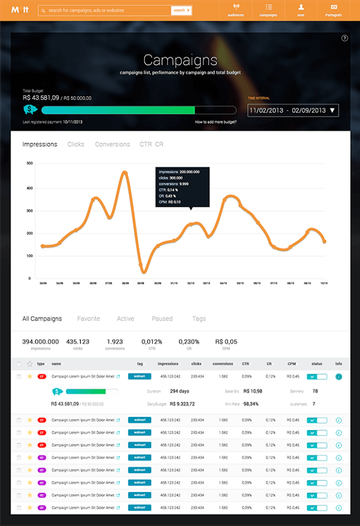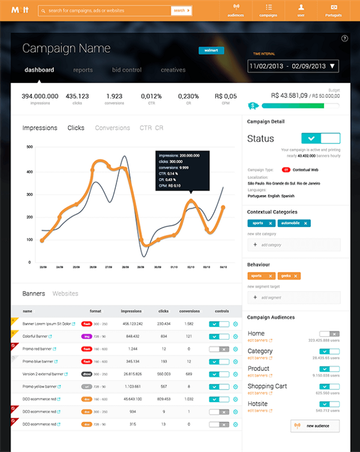A DSP campaign and ad management interface redesign
- My role
- User research and UI design.
- My role
- User research and UI design.

The main purpose of a DSP interface is to enable the creation of digital marketing campaigns automatically, which run on multiple ad networks simultaneously. DSP manages where each media will appear according to the lowest price or best audience.
This is a simplified definition, but with it you can see how an interface for this type of service can be complicated because it deals with the structuring of a little known service concept (even in the world of marketing) money and agility. In the case of Melt, the first interface is designed to be as self-service as possible. Many concepts have been simplified to the extreme and there have been no user testing before its release.

That’s why for a while there was no need for a new interface to the platform. Major external and internal clients used the old platform, and any advanced change was built directly into the backend or modeled on (in one of) the databases.
In this project, my role was as researcher and designer of the new interface.
Research
The main reason for changing the layout was the need to adapt the old interface to the new features and some customer requests.
We’ve done some usability testing and contextual interviews to deepen these insights. Based on the research and conceptualization of the product, we realized that some problems of a great portion of the users were not being met:
- From advanced campaign configuration, defining the BID for each campaign variable, to greater control of spending on each action, there was a greater need for user control
- Customers did not implement the frontend tags correctly and the contact was always with the developer
- Control of the money spent was the primary concern
- Some more seasoned clients asked to fine-tune campaign spending
- Some customers worried too much about the place where ads were served
- It was hard to understanding the list of banners and websites where the ads will be showed
- The interface was praised for simplicity despite the difficulty of use and constant errors
Based on this information we designed the new interface:
The new interface

Overall, we are looking to upgrade the platform to new technology and solve usability issues found in both testing and day-to-day with customers.
Here are some key principles:
Campaign changes should be more natural and responsive
Starting or Pausing a campaign were difficult tasks such as categorizing appropriately, adjusting the locale, language of the sites, or campaign type. Therefore, the proposed solution was to present the most important controls in the dashboard of the campaign (screen where the users stayed more time during the use of the platform)
To improve the visibility of system status, we also suggest the real-time display of platform activity, ie the number of ad impressions in the last hour.
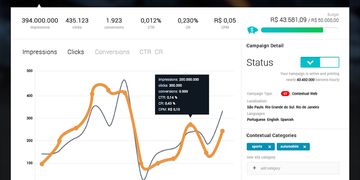
The customer should have greater control over the performance of each campaign separately
Customers often created campaigns over time and the financial expense was shared among all of them, bringing confusion to the customer. The idea of transforming this type of information into a table has this principles:
- Organize view of campaign characteristics
- Separate and compare indicators
- Create specific quick access controls for each campaign without taking the whole view
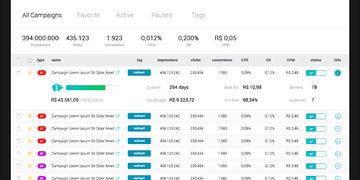
Data visualization should aid decision making
For this type of platform, graphics have severe limitations. Therefore, the solution could be to present the maximum of numerical information at each point of the performance line. This would make it easier to understand problems in overall campaign performance.
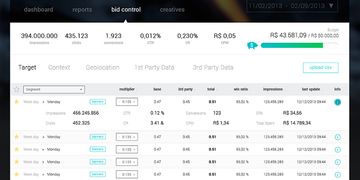
Spending on every aspect of the campaign was critical.
Some customers prefer to calculate exactly how much they intend to spend on each day of the week, time, context, location, and target audience to maximize performance. Because this work was manual and depended on developers, a screen with this kind of control would be extremely useful.
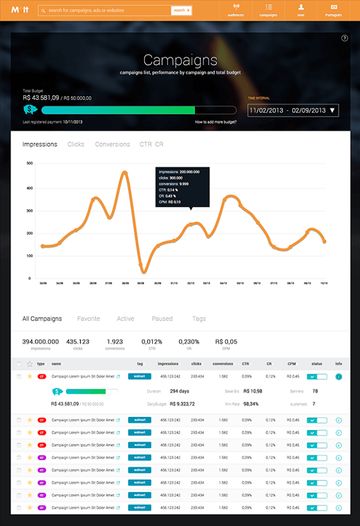
Other gains
- New controls should not confuse the current customer
- The new interface should support a greater amount of data and guide the customer
The Main Screens
